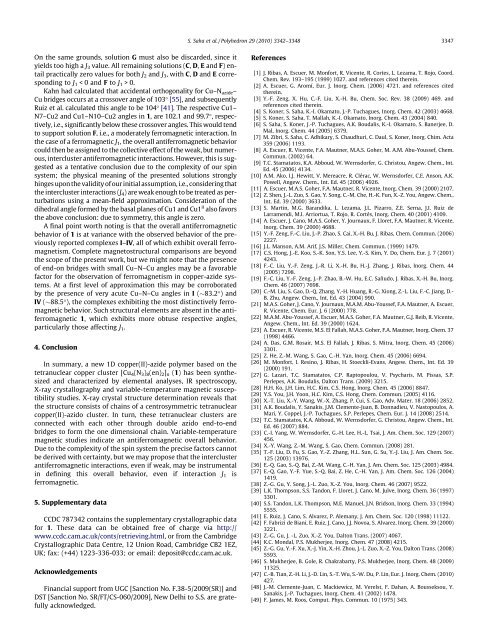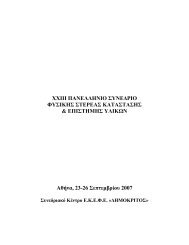Cluster based copper(II)-azide polymer: Synthesis, structure and ...
Cluster based copper(II)-azide polymer: Synthesis, structure and ...
Cluster based copper(II)-azide polymer: Synthesis, structure and ...
You also want an ePaper? Increase the reach of your titles
YUMPU automatically turns print PDFs into web optimized ePapers that Google loves.
S. Saha et al. / Polyhedron 29 (2010) 3342–3348 3347On the same grounds, solution G must also be discarded, since ityields too high a J 3 value. All remaining solutions (C, D, E <strong>and</strong> F) entailpractically zero values for both J 2 <strong>and</strong> J 3 , with C, D <strong>and</strong> E correspondingto J 1 < 0 <strong>and</strong> F to J 1 >0.Kahn had calculated that accidental orthogonality for Cu–N <strong>azide</strong> –Cu bridges occurs at a crossover angle of 103° [55], <strong>and</strong> subsequentlyRuiz et al. calculated this angle to be 104° [41]. The respective Cu1–N7–Cu2 <strong>and</strong> Cu1–N10–Cu2 angles in 1, are 102.1 <strong>and</strong> 99.7°, respectively,i.e., significantly below these crossover angles. This would tendto support solution F, i.e., a moderately ferromagnetic interaction. Inthe case of a ferromagnetic J 1 , the overall antiferromagnetic behaviorcould then be assigned to the collective effect of the weak, but numerous,intercluster antiferromagnetic interactions. However, this is suggestedas a tentative conclusion due to the complexity of our spinsystem; the physical meaning of the presented solutions stronglyhinges upon the validity of our initial assumption, i.e., considering thatthe intercluster interactions (J 4 ) are weak enough to be treated as perturbationsusing a mean-field approximation. Consideration of thedihedral angle formed by the basal planes of Cu1 <strong>and</strong> Cu1 ii also favorsthe above conclusion: due to symmetry, this angle is zero.A final point worth noting is that the overall antiferromagneticbehavior of 1 is at variance with the observed behavior of the previouslyreported complexes I–IV, all of which exhibit overall ferromagnetism.Complete magnetostructural comparisons are beyondthe scope of the present work, but we might note that the presenceof end-on bridges with small Cu–N–Cu angles may be a favorablefactor for the observation of ferromagnetism in <strong>copper</strong>-<strong>azide</strong> systems.At a first level of approximation this may be corroboratedby the presence of very acute Cu–N–Cu angles in I (83.2°) <strong>and</strong>IV (88.5°), the complexes exhibiting the most distinctively ferromagneticbehavior. Such structural elements are absent in the antiferromagnetic1, which exhibits more obtuse respective angles,particularly those affecting J 1 .4. ConclusionIn summary, a new 1D <strong>copper</strong>(<strong>II</strong>)-<strong>azide</strong> <strong>polymer</strong> <strong>based</strong> on thetetranuclear <strong>copper</strong> cluster [Cu 4 (N 3 ) 8 (en) 2 ] n (1) has been synthesized<strong>and</strong> characterized by elemental analyses, IR spectroscopy,X-ray crystallography <strong>and</strong> variable-temperature magnetic susceptibilitystudies. X-ray crystal <strong>structure</strong> determination reveals thatthe <strong>structure</strong> consists of chains of a centrosymmetric tetranuclear<strong>copper</strong>(<strong>II</strong>)-azido cluster. In turn, these tetranuclear clusters areconnected with each other through double azido end-to-endbridges to form the one dimensional chain. Variable-temperaturemagnetic studies indicate an antiferromagnetic overall behavior.Due to the complexity of the spin system the precise factors cannotbe derived with certainty, but we may propose that the interclusterantiferromagnetic interactions, even if weak, may be instrumentalin defining this overall behavior, even if interaction J 1 isferromagnetic.5. Supplementary dataCCDC 787342 contains the supplementary crystallographic datafor 1. These data can be obtained free of charge via http://www.ccdc.cam.ac.uk/conts/retrieving.html, or from the CambridgeCrystallographic Data Centre, 12 Union Road, Cambridge CB2 1EZ,UK; fax: (+44) 1223-336-033; or email: deposit@ccdc.cam.ac.uk.AcknowledgementsFinancial support from UGC [Sanction No. F.38-5/2009(SR)] <strong>and</strong>DST [Sanction No. SR/FT/CS-060/2009], New Delhi to S.S. are gratefullyacknowledged.References[1] J. Ribas, A. Escuer, M. Monfort, R. Vicente, R. Cortes, L. Lezama, T. Rojo, Coord.Chem. Rev. 193–195 (1999) 1027. <strong>and</strong> references cited therein.[2] A. Escuer, G. Aromí, Eur. J. Inorg. Chem. (2006) 4721. <strong>and</strong> references citedtherein.[3] Y.-F. Zeng, X. Hu, C.-F. Liu, X.-H. Bu, Chem. Soc. Rev. 38 (2009) 469. <strong>and</strong>references cited therein.[4] S. Koner, S. Saha, K.-I. Okamato, J.-P. Tuchagues, Inorg. Chem. 42 (2003) 4668.[5] S. Koner, S. Saha, T. Mallah, K.-I. Okamato, Inorg. Chem. 43 (2004) 840.[6] S. Saha, S. Koner, J.-P. Tuchagues, A.K. Boudalis, K.-I. Okamato, S. Banerjee, D.Mal, Inorg. Chem. 44 (2005) 6379.[7] M. Zibri, S. Saha, C. Adhikary, S. Chaudhuri, C. Daul, S. Koner, Inorg. Chim. Acta359 (2006) 1193.[8] A. Escuer, R. Vicente, F.A. Mautner, M.A.S. Goher, M. A.M. Abu-Youssef, Chem.Commun. (2002) 64.[9] T.C. Stamatatos, K.A. Abboud, W. Wernsdorfer, G. Christou, Angew. Chem., Int.Ed. 45 (2006) 4134.[10] A.M. Ako, I.J. Hewitt, V. Mereacre, R. Clérac, W. Wernsdorfer, C.E. Anson, A.K.Powell, Angew. Chem., Int. Ed. 45 (2006) 4926.[11] A. Escuer, M.A.S. Goher, F.A. Mautner, R. Vicente, Inorg. Chem. 39 (2000) 2107.[12] Z. Shen, J.-L. Zuo, S. Gao, Y. Song, C.-M. Che, H.-K. Fun, X.-Z. You, Angew. Chem.,Int. Ed. 39 (2000) 3633.[13] S. Martin, M.G. Bar<strong>and</strong>ika, L. Lezama, J.L. Pizarro, Z.E. Serna, J.I. Ruiz deLarramendi, M.I. Arriortua, T. Rojo, R. Cortés, Inorg. Chem. 40 (2001) 4109.[14] A. Escuer, J. Cano, M.A.S. Goher, Y. Journaux, F. Lloret, F.A. Mautner, R. Vicente,Inorg. Chem. 39 (2000) 4688.[15] Y.-F. Zeng, F.-C. Liu, J.-P. Zhao, S. Cai, X.-H. Bu, J. Ribas, Chem. Commun. (2006)2227.[16] J.L. Manson, A.M. Arif, J.S. Miller, Chem. Commun. (1999) 1479.[17] C.S. Hong, J.-E. Koo, S.-K. Son, Y.S. Lee, Y.-S. Kim, Y. Do, Chem. Eur. J. 7 (2001)4243.[18] F.-C. Liu, Y.-F. Zeng, J.-R. Li, X.-H. Bu, H.-J. Zhang, J. Ribas, Inorg. Chem. 44(2005) 7298.[19] F.-C. Liu, Y.-F. Zeng, J.-P. Zhao, B.-W. Hu, E.C. Sañudo, J. Ribas, X.-H. Bu, Inorg.Chem. 46 (2007) 7698.[20] C.-M. Liu, S. Gao, D.-Q. Zhang, Y.-H. Huang, R.-G. Xiong, Z.-L. Liu, F.-C. Jiang, D.-B. Zhu, Angew. Chem., Int. Ed. 43 (2004) 990.[21] M.A.S. Goher, J. Cano, Y. Journaux, M.A.M. Abu-Youssef, F.A. Mautner, A. Escuer,R. Vicente, Chem. Eur. J. 6 (2000) 778.[22] M.A.M. Abu-Youssef, A. Escuer, M.A.S. Goher, F.A. Mautner, G.J. Reib, R. Vicente,Angew. Chem., Int. Ed. 39 (2000) 1624.[23] A. Escuer, R. Vicente, M.S. El Fallah, M.A.S. Goher, F.A. Mautner, Inorg. Chem. 37(1998) 4466.[24] A. Das, G.M. Rosair, M.S. El Fallah, J. Ribas, S. Mitra, Inorg. Chem. 45 (2006)3301.[25] Z. He, Z.-M. Wang, S. Gao, C.-H. Yan, Inorg. Chem. 45 (2006) 6694.[26] M. Monfort, I. Resino, J. Ribas, H. Stoeckli-Evans, Angew. Chem., Int. Ed. 39(2000) 191.[27] G. Lazari, T.C. Stamatatos, C.P. Raptopoulou, V. Psycharis, M. Pissas, S.P.Perlepes, A.K. Boudalis, Dalton Trans. (2009) 3215.[28] H.H. Ko, J.H. Lim, H.C. Kim, C.S. Hong, Inorg. Chem. 45 (2006) 8847.[29] Y.S. You, J.H. Yoon, H.C. Kim, C.S. Hong, Chem. Commun. (2005) 4116.[30] X.-T. Liu, X.-Y. Wang, W.-X. Zhang, P. Cui, S. Gao, Adv. Mater. 18 (2006) 2852.[31] A.K. Boudalis, Y. Sanakis, J.M. Clemente-Juan, B. Donnadieu, V. Nastopoulos, A.Mari, Y. Coppel, J.-P. Tuchagues, S.P. Perlepes, Chem. Eur. J. 14 (2008) 2514.[32] T.C. Stamatatos, K.A. Abboud, W. Wernsdorfer, G. Christou, Angew. Chem., Int.Ed. 46 (2007) 884.[33] C.-I. Yang, W. Wernsdorfer, G.-H. Lee, H.-L. Tsai, J. Am. Chem. Soc. 129 (2007)456.[34] X.-Y. Wang, Z.-M. Wang, S. Gao, Chem. Commun. (2008) 281.[35] T.-F. Liu, D. Fu, S. Gao, Y.-Z. Zhang, H.L. Sun, G. Su, Y.-J. Liu, J. Am. Chem. Soc.125 (2003) 13976.[36] E.-Q. Gao, S.-Q. Bai, Z.-M. Wang, C.-H. Yan, J. Am. Chem. Soc. 125 (2003) 4984.[37] E.-Q. Gao, Y.-F. Yue, S.-Q. Bai, Z. He, C.-H. Yan, J. Am. Chem. Soc. 126 (2004)1419.[38] Z.-G. Gu, Y. Song, J.-L. Zuo, X.-Z. You, Inorg. Chem. 46 (2007) 9522.[39] L.K. Thompson, S.S. T<strong>and</strong>on, F. Lloret, J. Cano, M. Julve, Inorg. Chem. 36 (1997)3301.[40] S.S. T<strong>and</strong>on, L.K. Thompson, M.E. Manuel, J.N. Bridson, Inorg. Chem. 33 (1994)5555.[41] E. Ruiz, J. Cano, S. Alvarez, P. Alemany, J. Am. Chem. Soc. 120 (1998) 11122.[42] F. Fabrizi de Biani, E. Ruiz, J. Cano, J.J. Novoa, S. Alvarez, Inorg. Chem. 39 (2000)3221.[43] Z.-G. Gu, J. -L. Zuo, X.-Z. You, Dalton Trans. (2007) 4067.[44] K.C. Mondal, P.S. Mukherjee, Inorg. Chem. 47 (2008) 4215.[45] Z.-G. Gu, Y.-F. Xu, X.-J. Yin, X.-H. Zhou, J.-L. Zuo, X.-Z. You, Dalton Trans. (2008)5593.[46] S. Mukherjee, B. Gole, R. Chakrabarty, P.S. Mukherjee, Inorg. Chem. 48 (2009)11325.[47] C.-B. Tian, Z.-H. Li, J.-D. Lin, S.-T. Wu, S.-W. Du, P. Lin, Eur. J. Inorg. Chem. (2010)427.[48] J.-M. Clemente-Juan, C. Mackiewicz, M. Verelst, F. Dahan, A. Bousseksou, Y.Sanakis, J.-P. Tuchagues, Inorg. Chem. 41 (2002) 1478.[49] F. James, M. Roos, Comput. Phys. Commun. 10 (1975) 343.
















